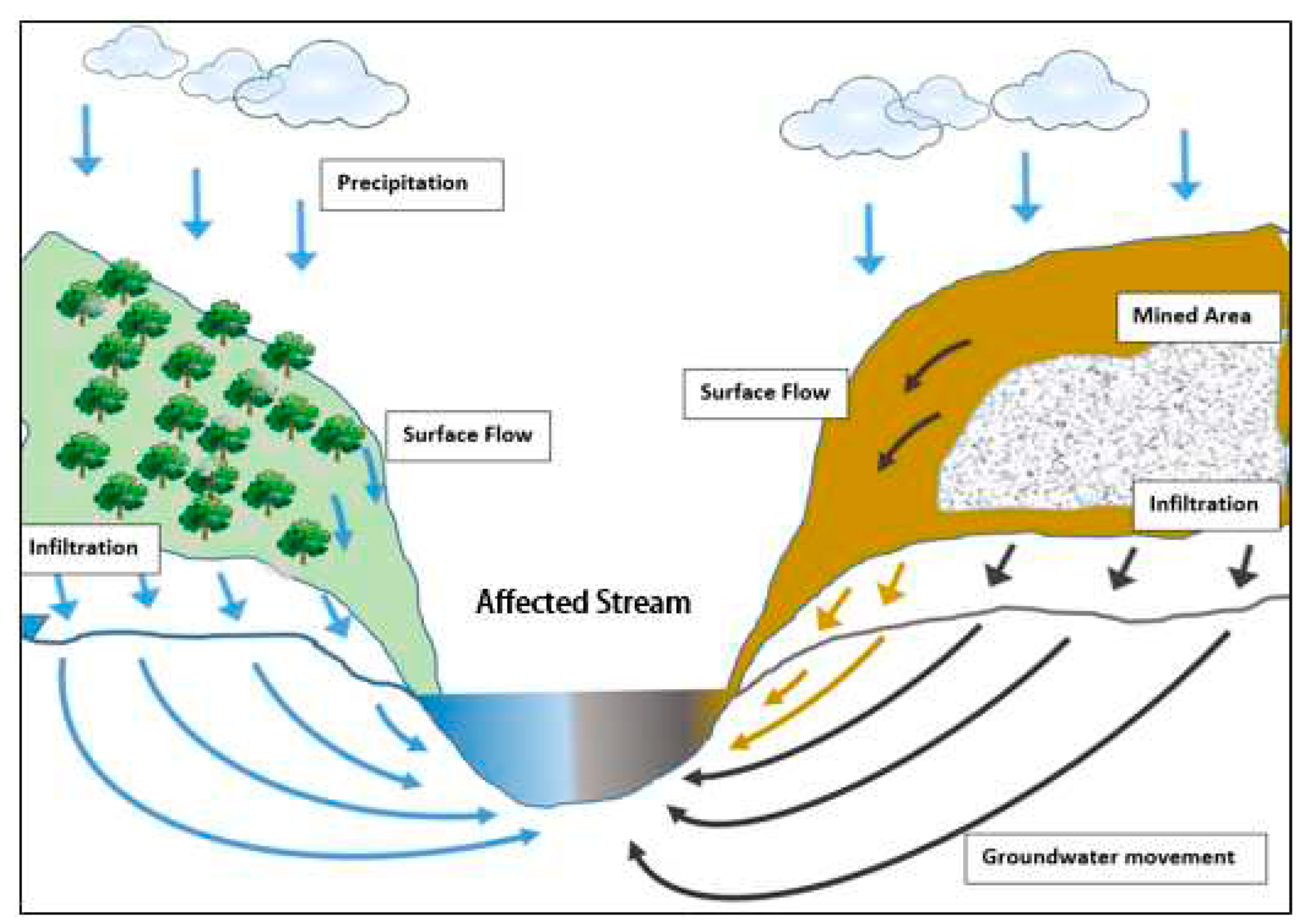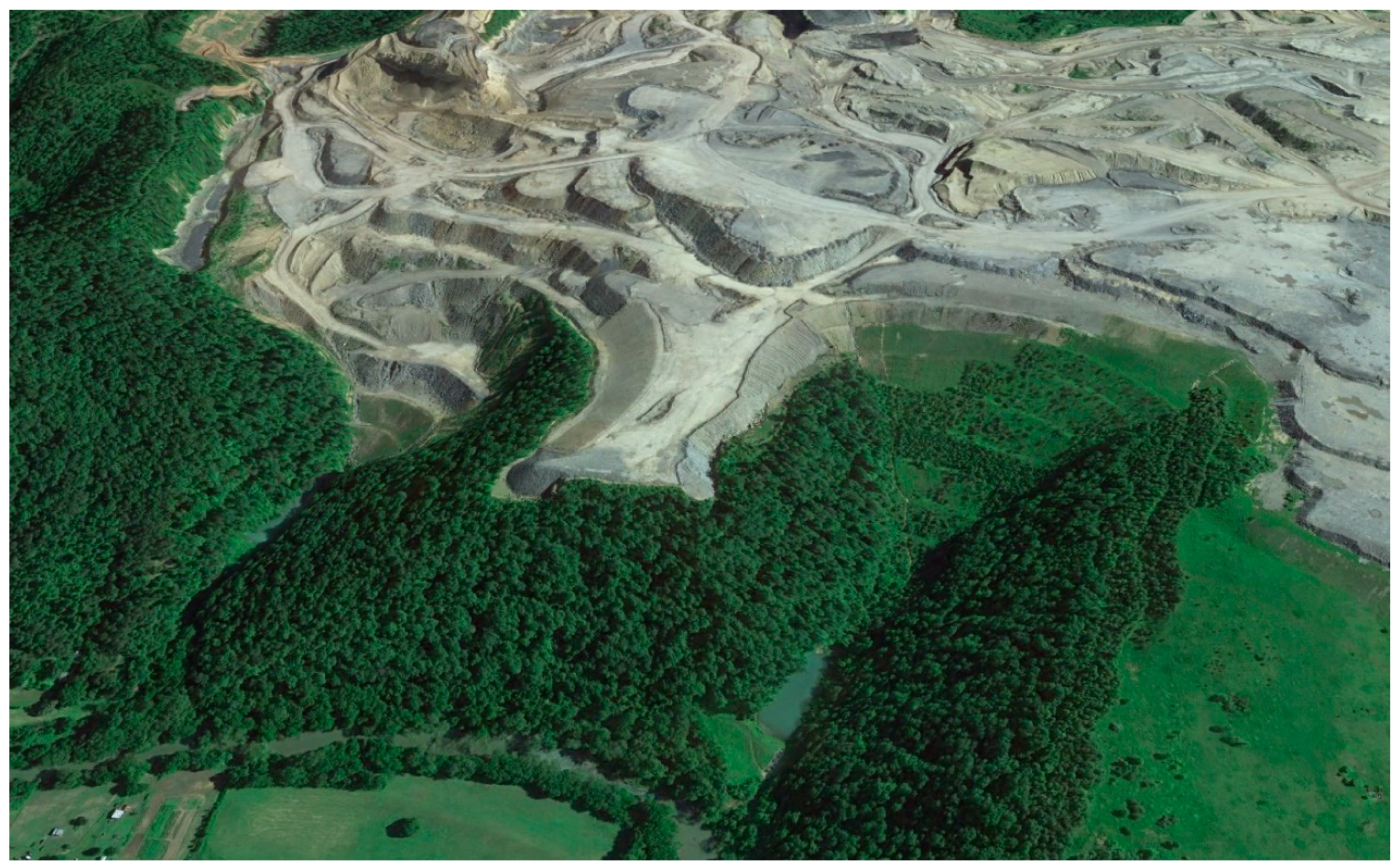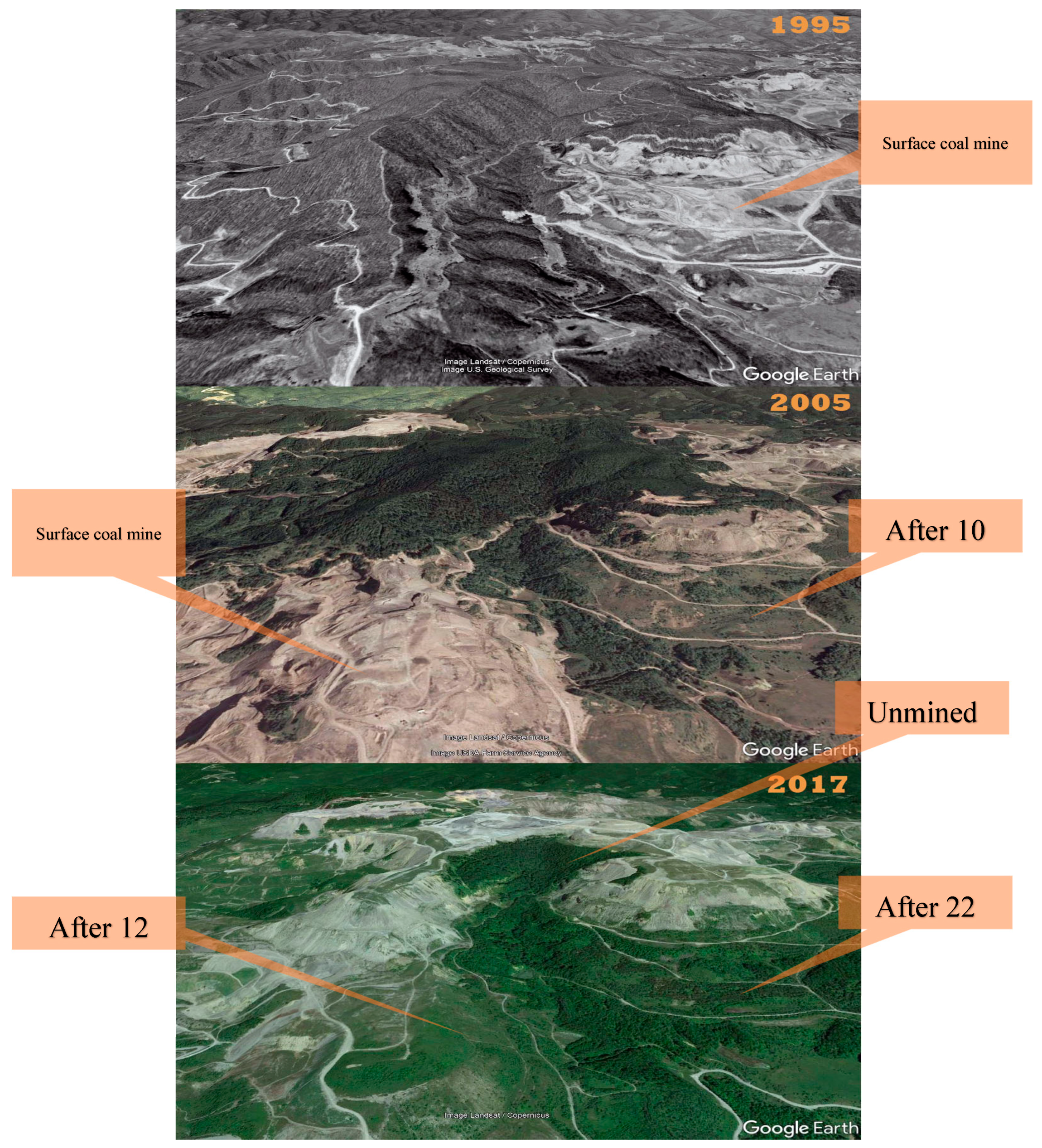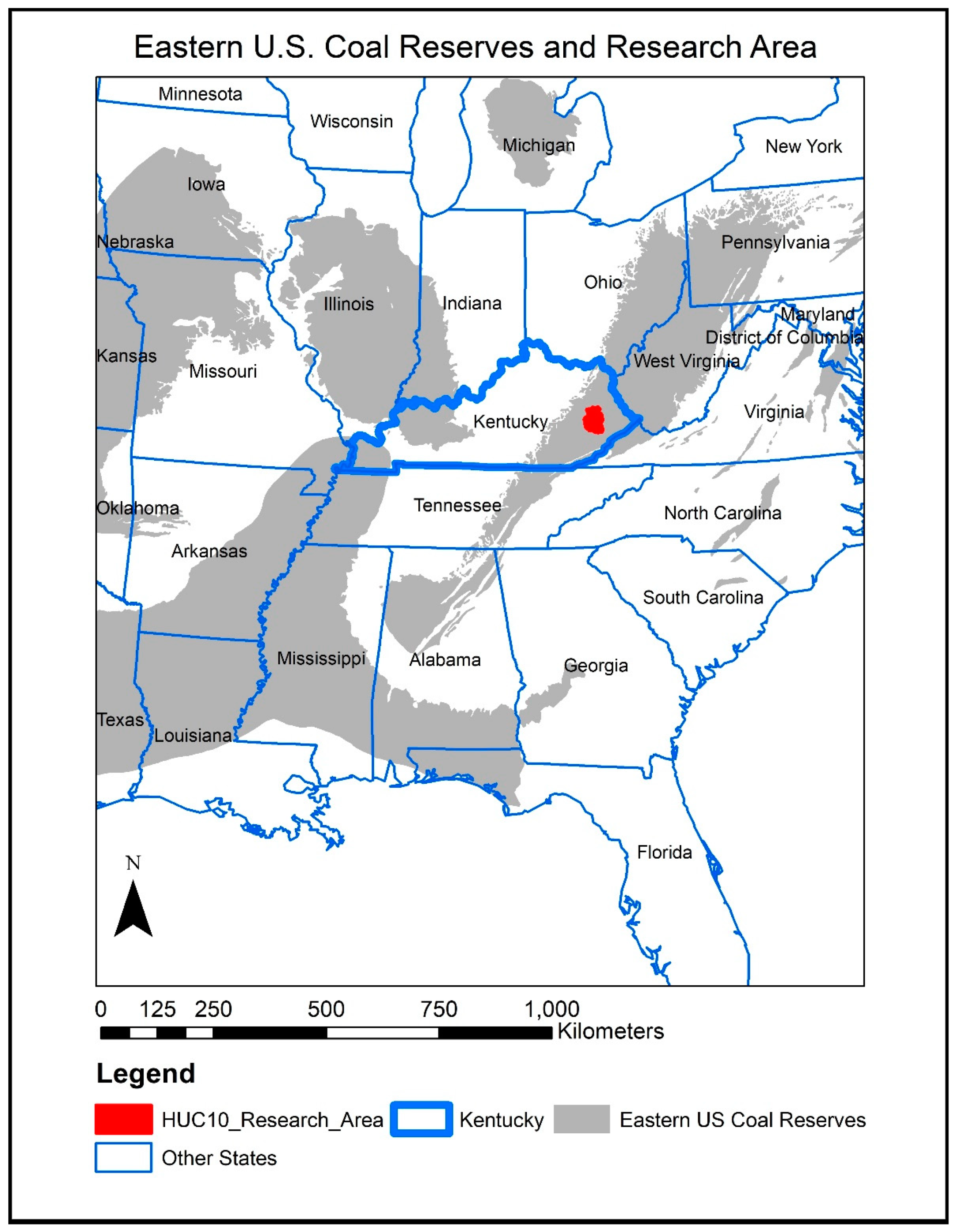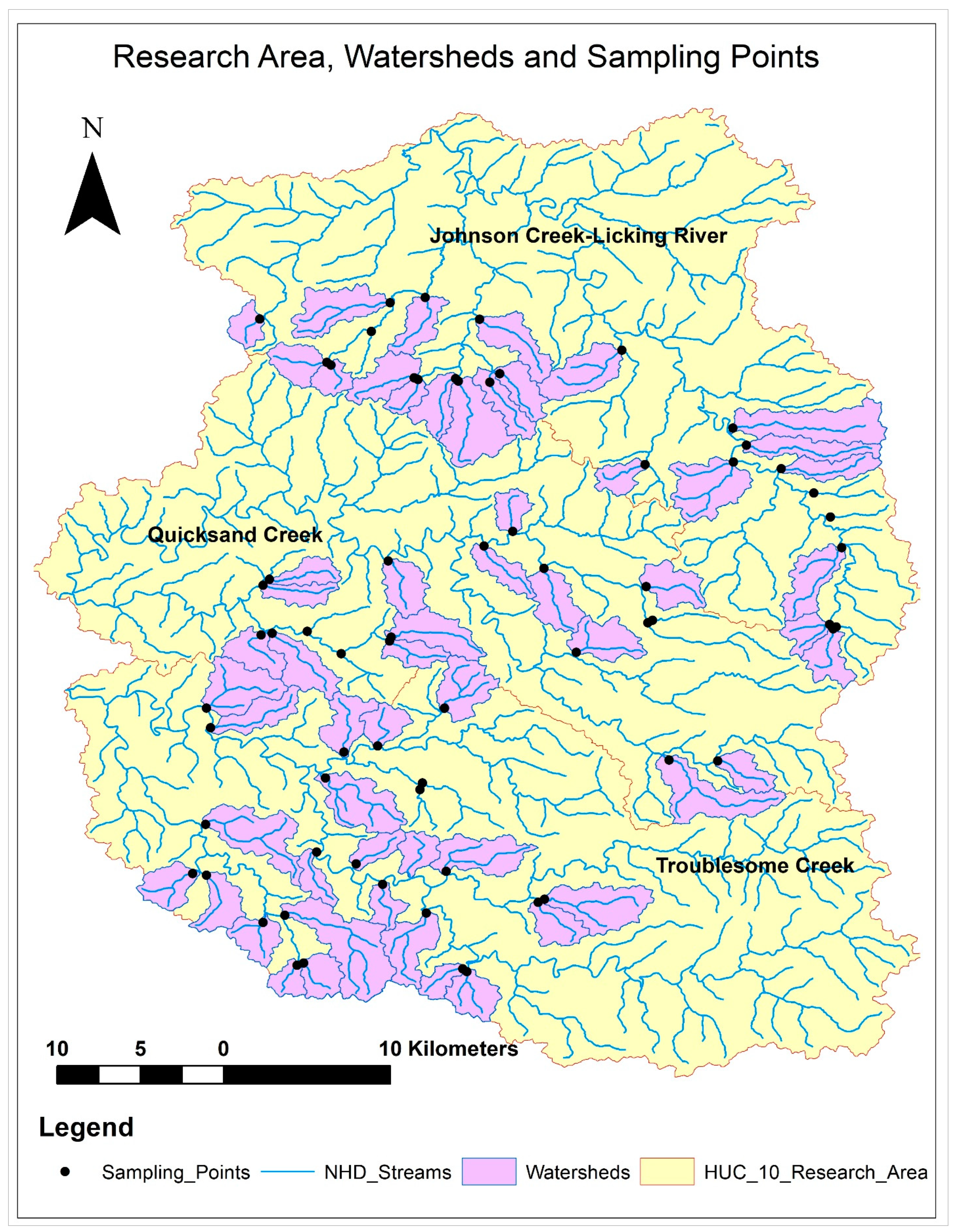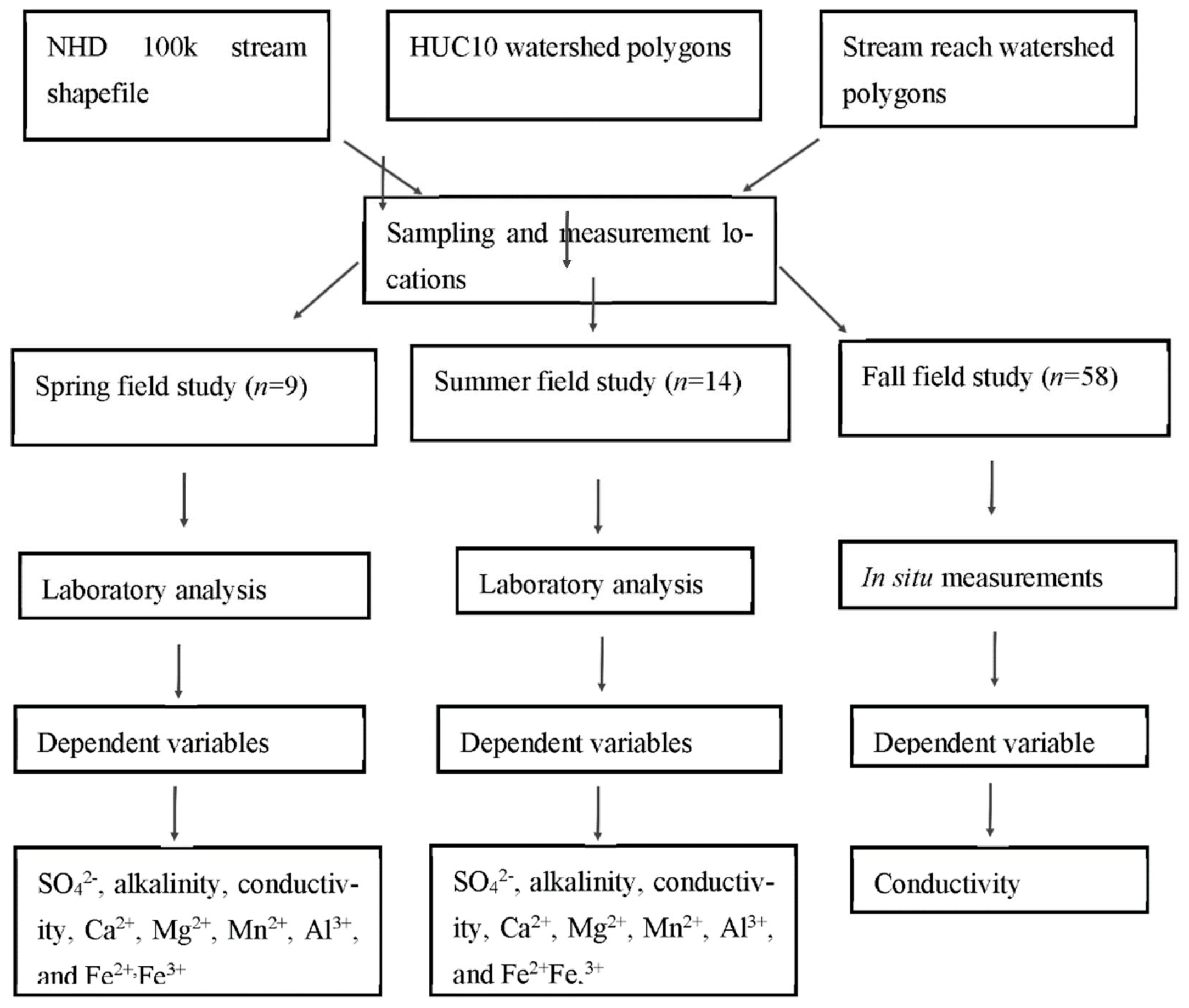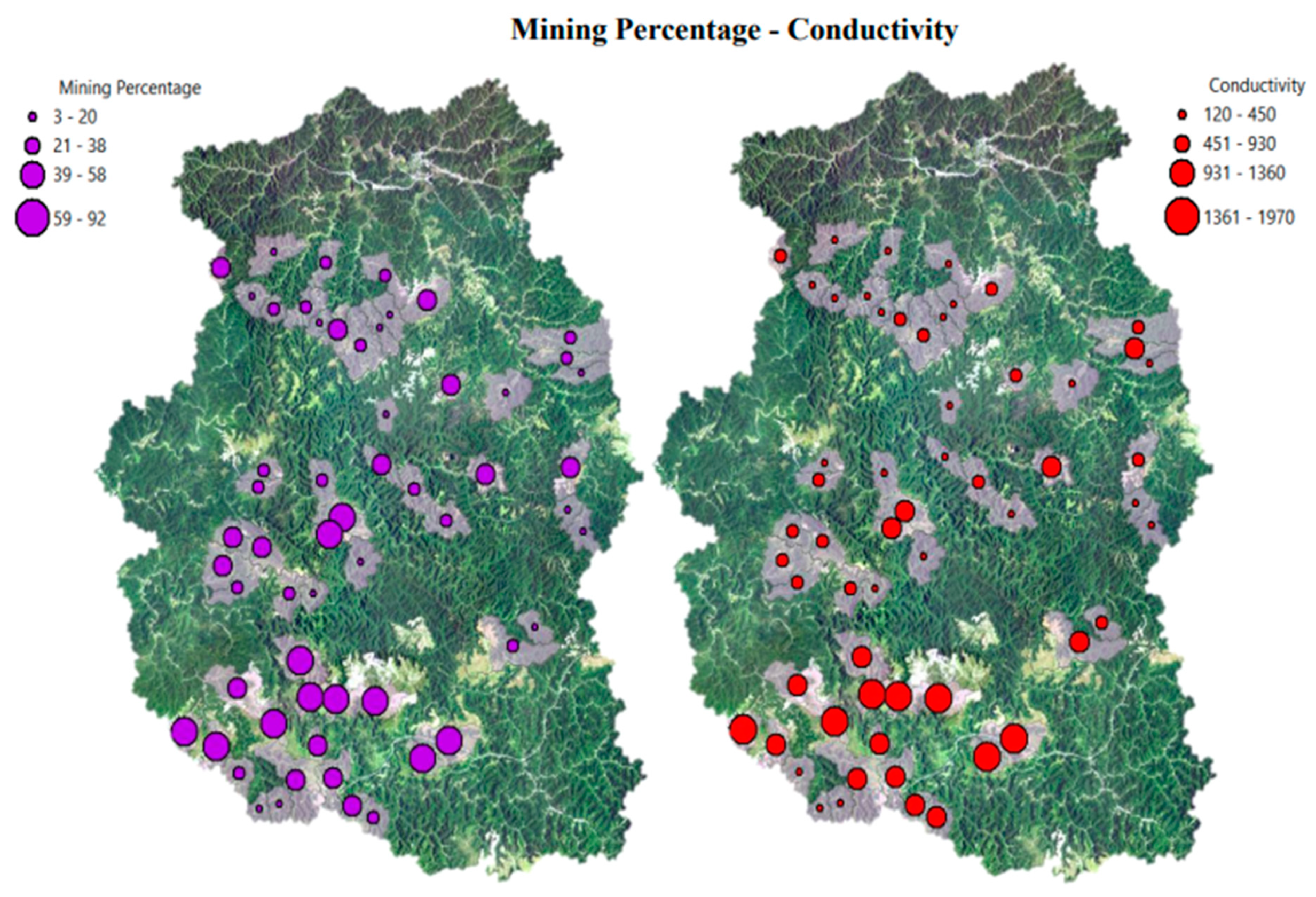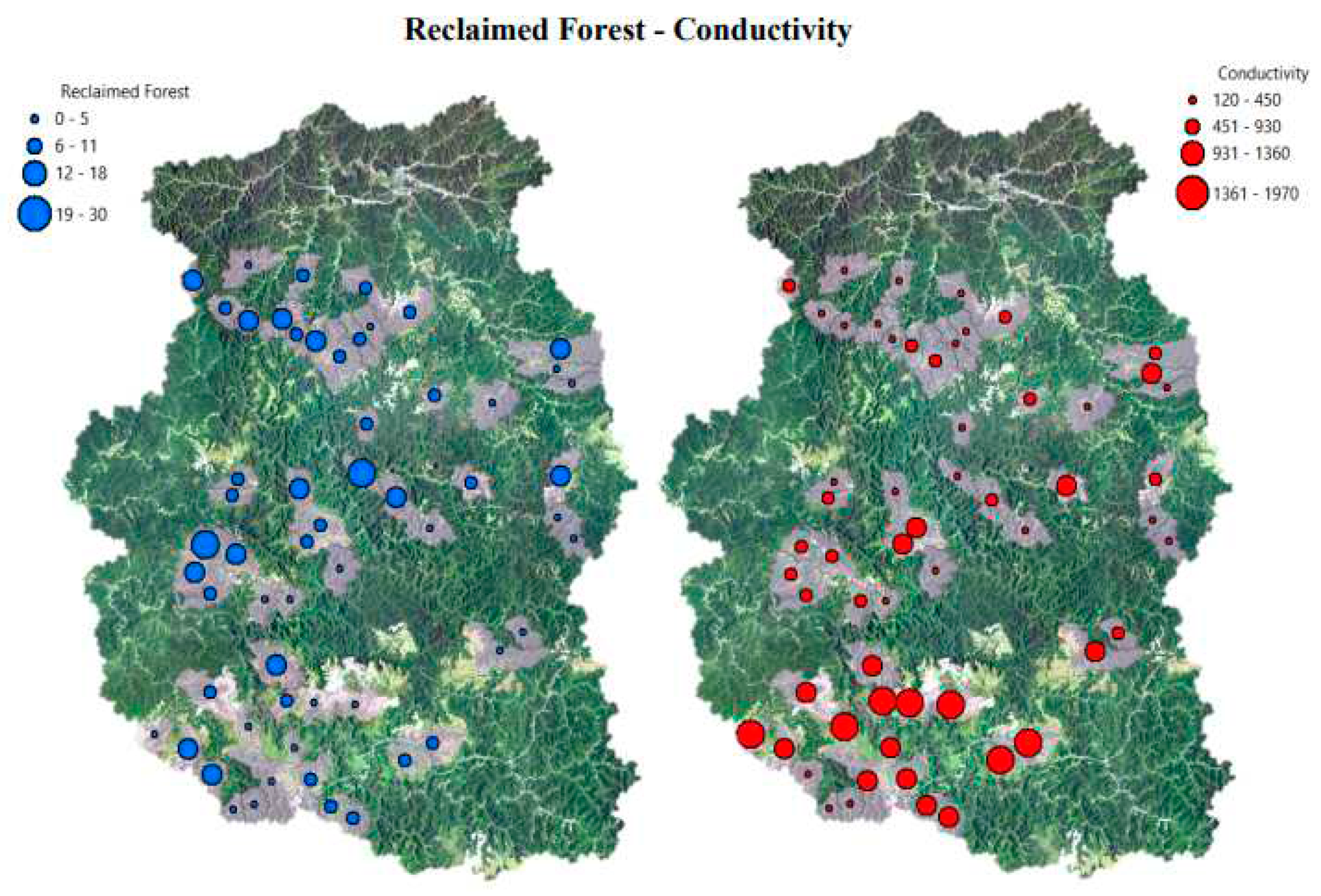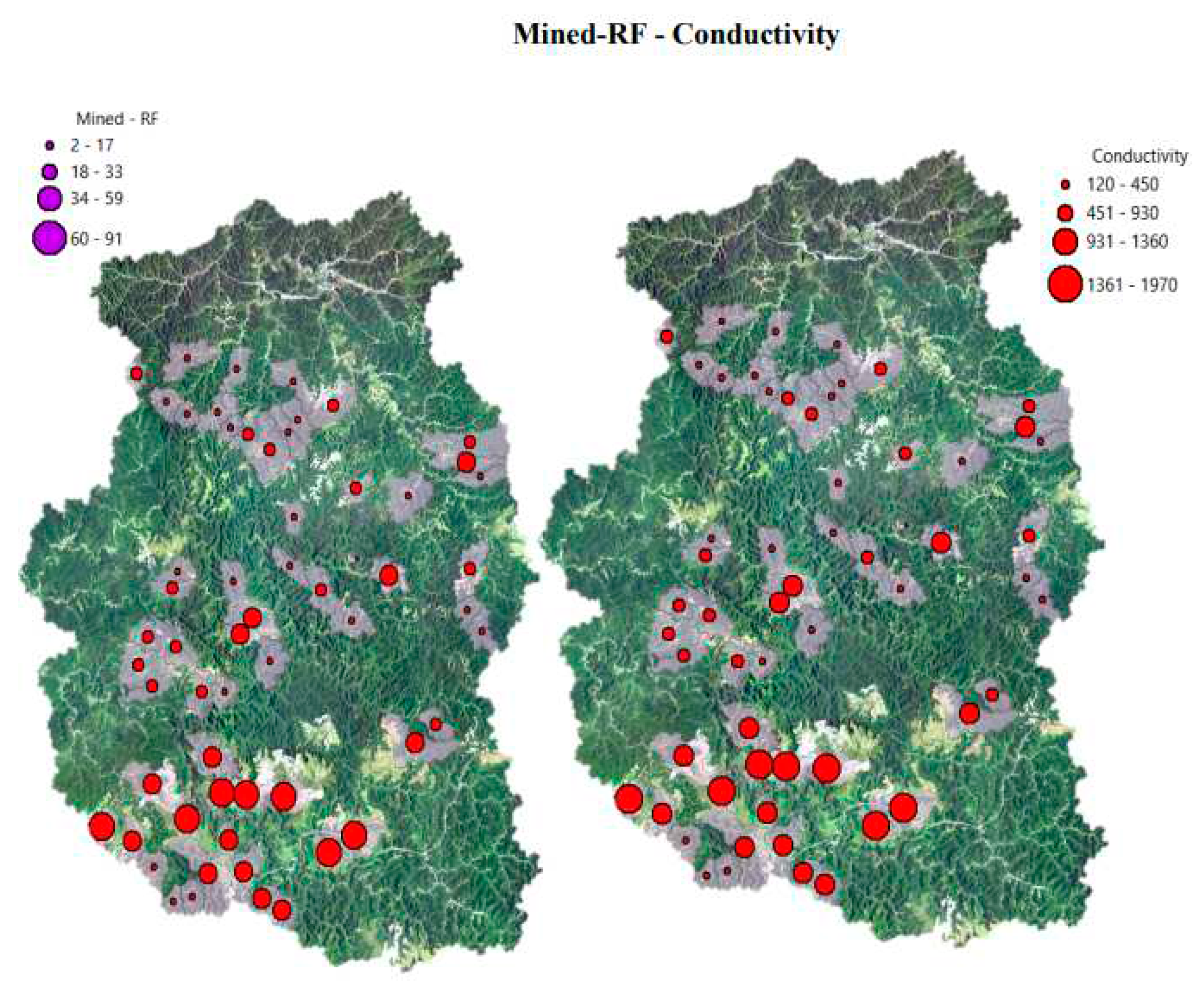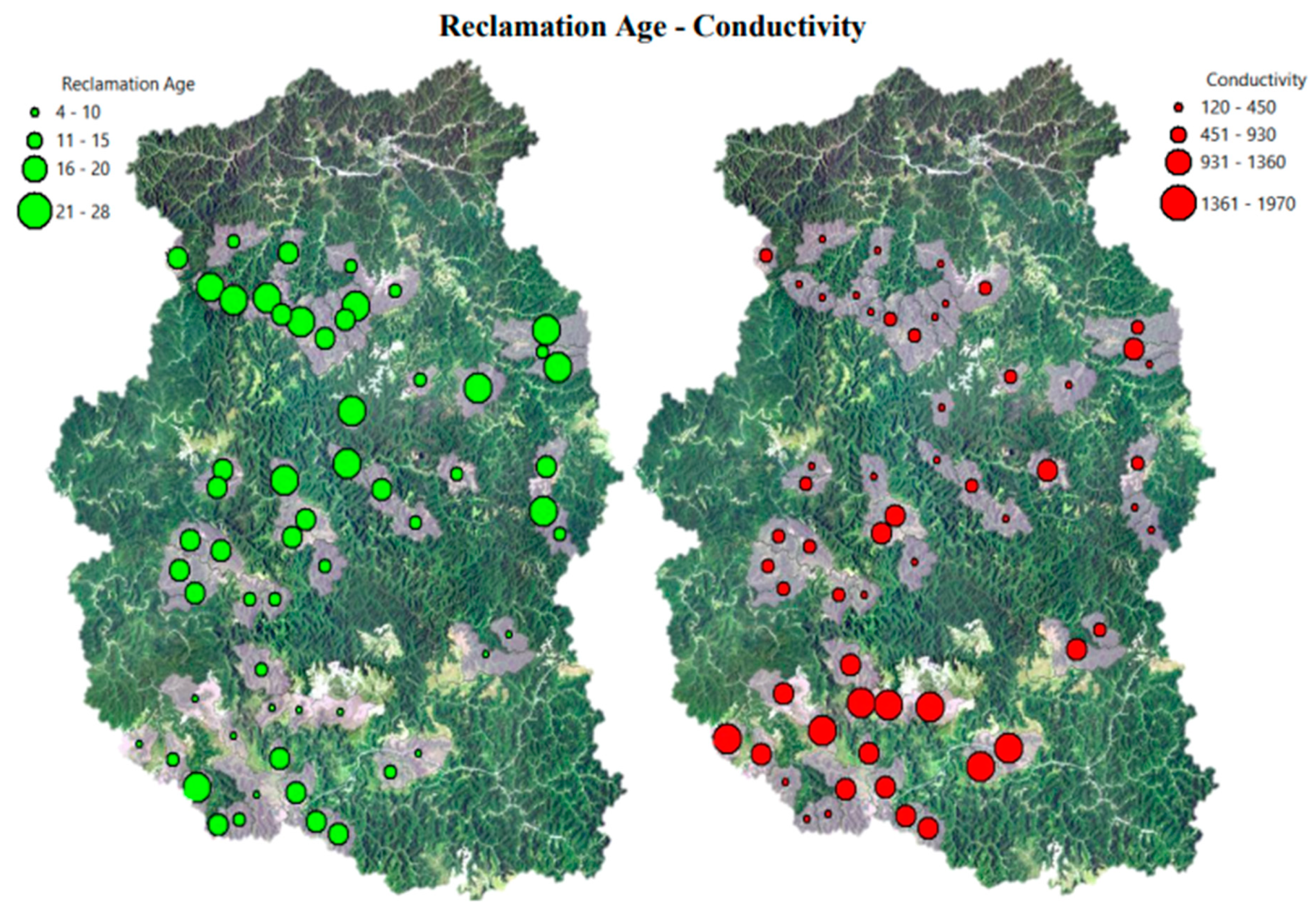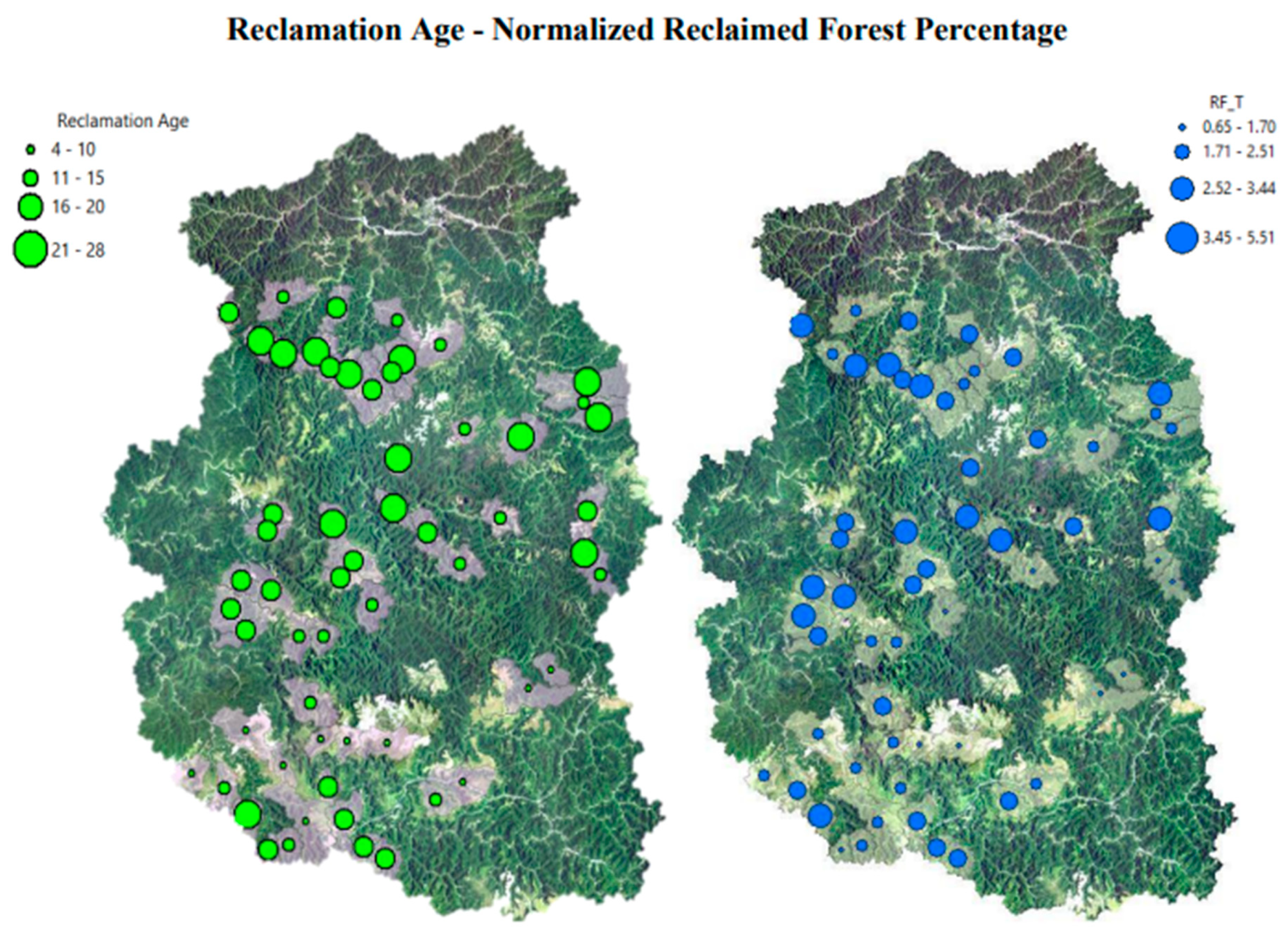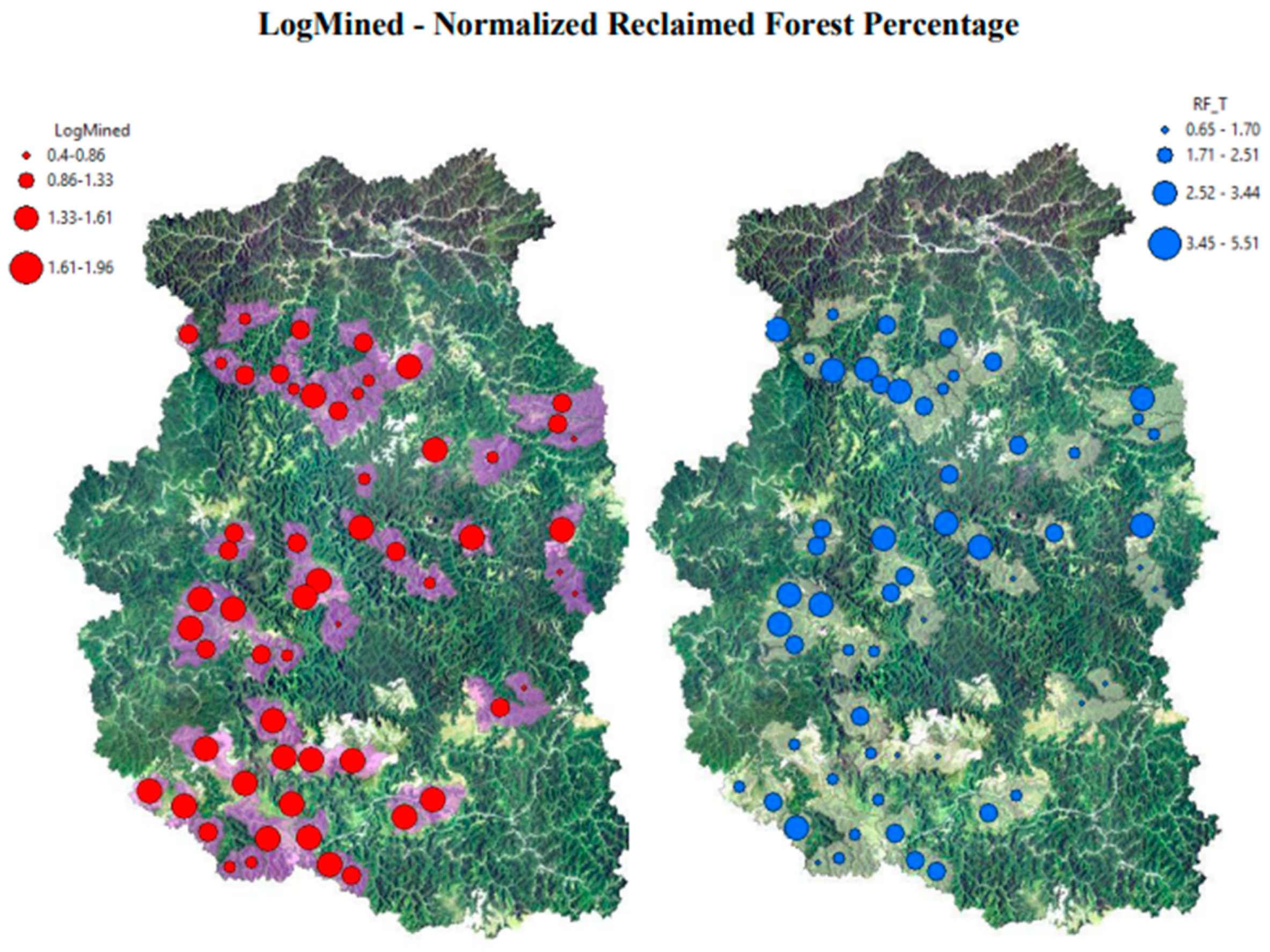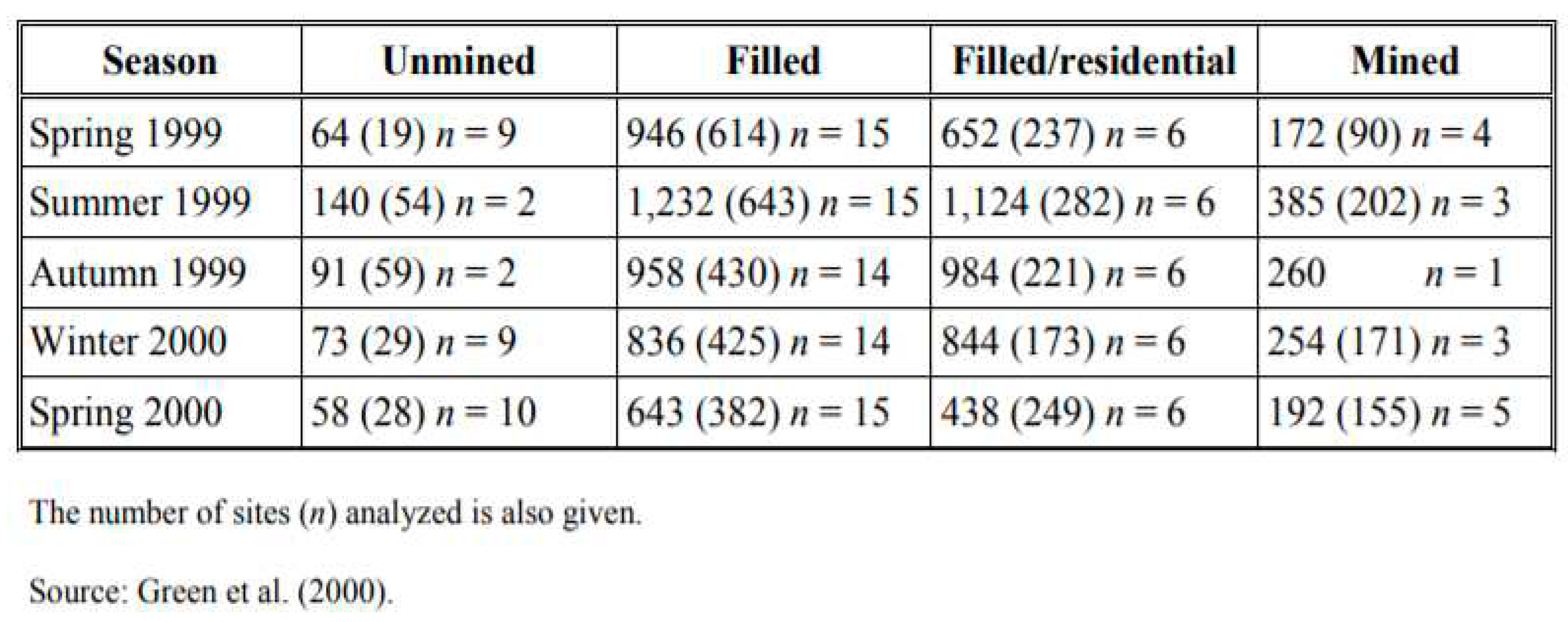1. Introduction
Water is one of the most essential natural resources on the earth but due to human activities including land use and climate change impacts the water quantity and quality and hence creates the water scarcity problems and threatens aquatic biodiversity (Vörösmarty et. al., 2010). Coal mining is one of the dominant factors to degrade water quality in the Appalachia region where hundreds of headwater streams impacted (Palmer et al., 2010; Holzman, 2011; Palmer and Hondula, 2014; Evans et al., 2021). Commercial coal production started in Kentucky even before Kentucky was recognized as a state. In 1790, 18 tons (20 short tons) of coal was produced in the first commercial coal operation in what is now Lee County. The demand for more energy led to an increase in coal production so that peak levels amount exceeded 162 million tons in 1990 [
1]. Kentucky was the fifth-largest coal-producing state in 2016 [
2] with 42 million tons of coal production (EEC, 2018). Seventy-nine percent of Kentucky's net electricity generation was coal-fired in 2017 [
2] although production has declined consistently since 1990.
Even though coal-generated electricity is less expensive than other energy sources, its impact on the environment and humans is under debate [
3,
4]. The Surface Mining Control and Reclamation Act (SMCRA) of 1977 created two programs: one for regulating active coal mines and a second for reclaiming abandoned mine lands [
5]. Many studies, however, have shown that reclamation practices do not produce very effective results [
3,
4,
6,
7].
Major coal mining impacts generally observed in Kentucky and Central Appalachia are natural land cover loss, hydrological pattern changes, valley fill, acid drainage, and water quality degradation (
Figure 1; [
3]). Mountaintop coal mining, which is widely used in the Appalachian region, involves blasting rocks, clearing forests, and removing soil to reach coal reserves [
8,
9]. For example, the landscape was greatly modified by smelting and mining activities in Copperhill, Tennessee which is situated in the Blue Ridge Mountains at the convergence of Northern Georgia, Western North Carolina, and Southern Tennessee which was began in 1854 and landscape appeared desert-like during 1900s (Baes and McLaughlin, 1984; Newman 2020). Central Appalachia has the highest earth movement rate in the United States with each surface mine generating large quantities of spoil that are typically translocated to stream valleys close to mining areas [
10]. Mountaintop removal coal mining requires forest clearing, which in some cases may be visible on the 1: 3,000,000 scale from National Agriculture Imagery Program (NAIP) aerial Images. Mountaintop mining poses a potential threat to intact characteristics of Appalachian forests [
11]. Interior forest loss (change in interior forest to forest edge) in southern Appalachia between 1991 and 2002 was 1.75 to five times higher than direct forest loss (loss from edges), which may have been the result of mountaintop mining [
12]. Land cover alterations from active mine to reclaimed mines in central Appalachia almost entirely occurred in forested areas [
3].
The Forest Reclamation Approach (FRA) provides a set of guidelines that are based on research conducted over several decades to promote the regrowth of forests on reclaimed mine lands which requires using loose soil [
7]. This could potentially lead to elevated concentration of ions and metals; moreover, the effect of FRA on water quality needs further investigation [
9]. The potential for total dissolved solids-source control practices that incorporate FRA may improve mine-water quality [
7]. The effect of FRA on water quality may require additional data on the spatial extent of FRA locations and reclamation age.
Reclaimed forests and areas can be detected with remote sensing techniques [
13,
14,
15] and assessed in relation to water quality. [
16] found that, after seven years of monitoring, water quality improvement was more obvious in sub-watersheds that were heavily affected by past mining activities and reclaimed by reforestation than in lands with abandoned mines. These findings demonstrate that good reclamation practices can have a positive influence on water quality over time.
Besides forest loss, surface coal mining may have a significant effect on soil hydrological properties [
3]. Surface mining may have negative effects on watershed hydrologic characteristics [
6,
17,
18]. Valley fills can bury headwater streams under tens to hundreds of meters of spoil [
8,
9], which minimizes the drainage capacity of a valley (
Figure 2).
[
19] researched hydrologic differences in a reforested area and a grass covered area that were reclaimed 14 years prior to the study with similar processes. The reforested area had a higher infiltration rate and the grassy area had more surface flow paths; however, the water quality in these two areas was not documented.
Figure 3 displays how surface mining affects the natural land cover and the appearance of land cover during recovery.
The Clean Water Act Amendment of 1972 (CWA) established standards for regulating pollutant discharges into surface water [
20]. However, groundwater and surface water from mined areas may be contaminated with numerous toxic solutes such as sulfate (SO
42-), iron (Fe), aluminum (Al), and selenium (Se) [
21,
22]. Increased conductivity, pH changes, and elevated dissolved ion levels are commonly found in streams near surface mines [
4]. A relationship exists between water quality degradation and coal mining at various scale of watersheds, e.g., elevated SO
4 2-, alkalinity, conductivity, Ca
2+, Mg
2+, Mn
2+, Al
3+, and Fe
2+,3+ [
4,
7,
23,
24,
25,
26].
[
27] found that conductivity fluctuated seasonally and was highest in summer and lowest in spring, which may be due to the dilution effect of water in the watershed. Similarly, in consecutive seasons, conductivity was two or more times higher in mined watersheds than unmined watersheds [23, 27,
Table 1). These findings suggest that precipitation or seasonal conditions may affect the results; however, differences between unmined and mined areas are stable if water samples are collected under the same conditions, e.g., at the same season and a clear day without rain.
Coal mining typically releases pyrite (Fe
2S), which forms in association with coal [
28,
29,
30,
31,
32]. When pyrite comes in contact with water and oxygen, it is oxidized by autotrophic bacteria, leading to acid mine drainage (
Equation 1; [
33]):
Carbonate minerals, e.g., calcite (CaCO
3) and dolomite (CaMg(CO
3)
2), can neutralize the acidity (
Equations 2 and 3; [
34]).
Using the equations above, in addition to previous studies, SO42-, alkalinity, conductivity, Ca2+, Mg2+, Mn2+, Al3+, and Fe2+,3+ values in streams near coal mines can be described as coal mine-related stream chemistry (CMRSC).
Topographic variables may play role in stream chemistry even though they have been used rarely by coal mine-water quality researchers. However, some land cover change (urban, agriculture) studies utilized topographic variables as contributing factors to stream chemistry [
35,
36]. [
36] found mean watershed elevation and slope significantly correlated with conductivity. Contrarily, [
35] did not find any significant relationship among watershed slope, drainage density, and conductivity. [
25] did not find any relation between elevation and stream chemistry in coal mine sites.
Various studies have documented a negative correlation between coal mining and the health of local ecology, stream habitat, community structure, and ecosystem functions [
37,
38,
39]. Prior studies have focused on water quality degradation [
4,
7,
23,
25] or land change due to coal mining [
3,
12] whereas few studies have focused on CMRSC on mined watersheds along with land change [
26,
39,
40], specifically vegetation cover change in eastern Kentucky. Among those studies that have been conducted in this area, [
26] found a high correlation between mining percentage and SO
4-2 and conductivity while [
40] created a general linear model between land use (surface mining, residential development, and underground mining) and specific conductivity. Future comprehensive research should focus on the interrelationship among land, vegetation, and water quality changes over the years after disturbances caused by active mining and reclamation [
26]. Moreover, data are needed to determine how the spatial and temporal extent of surface coal mining affects the watershed based on the vegetation cover change, reclamation age, and topographic factors. The aim of the current research was to examine how coal mining affects water quality and temporal vegetation cover change between 1986-2017 in mined watersheds on a regional scale.
4. Conclusions
This study explored the relationships between water quality parameters, reclaimed forest percentage (dependent variables), mining percentage, reclamation age, reclaimed woods, slope, elevation, drainage density, and infiltration in stream-reach watersheds affected by coal mining. We found that reclamation age is a significant factor for predicting conductivity in reclaimed mines. Even though reclamation age was not a primary factor, Reclamation age appeared to increase the accuracy of the conductivity prediction although reclamation age was not a primary factor accounting for it increased the accuracy of the conductivity prediction. This research used more convenient and accurate methods for collecting and analyzing the data about mining percentage and reclamation age than the previous studies in the Appalachia region (states Furthermore, reclamation age and topographic factors were not evaluated on a regional scale in previous studies.
We also investigated the effects of reclaimed forest and reclaimed woods on conductivity to improve the Regression Model A, which included only mining percentage (mined) and reclamation age for conductivity prediction. We did not find a direct relation between conductivity and reclaimed forest percentage or reclaimed woods percentage; however, by removing reclaimed forest and performing correlation of mining percentage with conductivity, we were able to moderately improve the results. The Regression Model A results were consistent with earlier studies that found coal mining had a major impact on water quality degradation and forest structure.
In addition, we used reclamation age and mining percentage to estimate the quantity of reclaimed forested areas in the watershed. Reclaimed forest quality is usually measured by comparing the resemblance to original forest. We concluded that the quality of reclaimed forest is important for evaluating reclamation success; however, quantity is equally important. Quantity of a reclaimed forest coupled with quality, provides a better assessment of reclaimed areas when advanced remote sensing techniques are used. For example, high resolution aerial images or Light Detection and Ranging (LIDAR) data may be used to define the composition of reclaimed forested area with accurate delineation of mined area.
We included topographic variables (slope, elevation, drainage density, and infiltration) to take into account possible influences of topographic variations in the regression models. The results indicated no such relation except infiltration was positively correlated with conductivity (fall), but this was not significant. Studies by [
25,
35] found similar results.
Overall, this study suggests that conductivity is a predictable water quality indicator that is highly associated with CMRSC where agriculture and urban areas are limited. Furthermore, our assessment of vegetation cover change may provide insight into reclamation success in terms of restoring deforested areas. Our findings may help the scientific community and regulating agencies improve their understanding of water quality characteristics in watersheds affected by coal mining. This can be accomplished by refining land reclamation practices and monitoring protocols.
Figure 1.
Effects of coal mining on stream water. Left side of valley (unmined): natural infiltration, precipitation infiltrated efficiently (e.g., trees intercept rain, roots create porosity, top soil provides effective infiltration). Right side of valley (mined): poor infiltration, stream pollution proportionally with mined area, surface flow not tolerated properly (e.g., compacted soil, top soil loss).
Figure 1.
Effects of coal mining on stream water. Left side of valley (unmined): natural infiltration, precipitation infiltrated efficiently (e.g., trees intercept rain, roots create porosity, top soil provides effective infiltration). Right side of valley (mined): poor infiltration, stream pollution proportionally with mined area, surface flow not tolerated properly (e.g., compacted soil, top soil loss).
Figure 2.
Valley fills near Chavies, Kentucky. Valley fill is an engineered earthen and rock structure where excess soil and rocks deposited from surface mining or in some cases underground mining. They built in approximately 1995 (right) and 2013 (left). They are 350 m. and 300 m. deep respectively. Source: Google Earth.
Figure 2.
Valley fills near Chavies, Kentucky. Valley fill is an engineered earthen and rock structure where excess soil and rocks deposited from surface mining or in some cases underground mining. They built in approximately 1995 (right) and 2013 (left). They are 350 m. and 300 m. deep respectively. Source: Google Earth.
Figure 3.
Photos from the same scene (near Whitesburg, Kentucky [37.031036, -82.710169]) in different years. Mined areas from 1995 turned to woods while mined areas from 2005 turned to grass and bush.
Figure 3.
Photos from the same scene (near Whitesburg, Kentucky [37.031036, -82.710169]) in different years. Mined areas from 1995 turned to woods while mined areas from 2005 turned to grass and bush.
Figure 4.
Eastern U.S. coal reserves and research area.
Figure 4.
Eastern U.S. coal reserves and research area.
Figure 5.
Research area, watersheds, and sampling locations.
Figure 5.
Research area, watersheds, and sampling locations.
Figure 6.
Water quality data analysis steps to assess variables.
Figure 6.
Water quality data analysis steps to assess variables.
Figure 8.
Mining percentage (independent variable) versus fall conductivity (dependent variable) values (n= 58, R=0.86, p < 0.01).
Figure 8.
Mining percentage (independent variable) versus fall conductivity (dependent variable) values (n= 58, R=0.86, p < 0.01).
Figure 9.
Reclaimed forest percentage (independent variable) versus fall conductivity (dependent variable) values (n=58, R=-0.07, p > 0.05).
Figure 9.
Reclaimed forest percentage (independent variable) versus fall conductivity (dependent variable) values (n=58, R=-0.07, p > 0.05).
Figure 10.
Mined-RF (mining percentage without reclaimed forest; independent variable) versus fall conductivity (dependent variable) values (n=58, R=0.90, p < 0.01).
Figure 10.
Mined-RF (mining percentage without reclaimed forest; independent variable) versus fall conductivity (dependent variable) values (n=58, R=0.90, p < 0.01).
Figure 11.
Reclamation age (independent variable) versus fall conductivity (dependent variable) values (n=58, R=-0.67, p < 0.01).
Figure 11.
Reclamation age (independent variable) versus fall conductivity (dependent variable) values (n=58, R=-0.67, p < 0.01).
Figure 12.
Reclamation age (Independent V.) versus normalized reclamation forest percentage (Dependent V.) values (n=58, R=0.50, p < 0.01).
Figure 12.
Reclamation age (Independent V.) versus normalized reclamation forest percentage (Dependent V.) values (n=58, R=0.50, p < 0.01).
Figure 13.
LogMined (Independent V.) versus normalized reclamation forest percentage (Dependent V.) values (n=58, R=0.45, p< 0.01).
Figure 13.
LogMined (Independent V.) versus normalized reclamation forest percentage (Dependent V.) values (n=58, R=0.45, p< 0.01).
Table 1.
Seasonal mean conductivity (µS/cm) values for four classes of streams (unmined, valley filled, valley fill with residences, mined with no valley fill) from [
27]. Numbers in parentheses are standard deviations. Unmined: non-mined areas; Filled: Valley fills with coal mine spoils; Filled/Residential: Valley fills and residential areas together; Mined: Mined areas without valley fills.
Table 1.
Seasonal mean conductivity (µS/cm) values for four classes of streams (unmined, valley filled, valley fill with residences, mined with no valley fill) from [
27]. Numbers in parentheses are standard deviations. Unmined: non-mined areas; Filled: Valley fills with coal mine spoils; Filled/Residential: Valley fills and residential areas together; Mined: Mined areas without valley fills.
Table 4.
Dependent and independent variables and their descriptions.
Table 4.
Dependent and independent variables and their descriptions.
| Dependent Variable |
Independent Variables |
Description |
| Conductivity (µS/cm): measurement in a stream at exit point of a watershed. |
Mined |
Percentage of total mined area in a watershed from 1986 to 2017. |
| Reclaimed Woods |
Percentage of reclaimed woods since 1986 in a watershed. |
| Reclaimed Forest |
Percentage of reclaimed forest land in a watershed since 1986 |
| Reclamation Age |
Average year passed since reclamation was enacted. In case of multi-temporal occurrence of reclamation, average age was calculated with weighting average by using area and year of reclamation. |
| Elevation |
Mean elevation (m.) for a watershed. |
| Slope |
Mean slope (deg.) value for a watershed. |
| Drainage Density |
Ratio of total stream length to area of a watershed (km-1). |
| Infiltration |
Numerical mean soil infiltration rate for a watershed which translated from categorical variable. |
| Reclaimed Forest (same as above) |
Mined |
Same as above |
| Reclamation Age |
Same as above |
| Elevation |
Same as above |
| Slope |
Same as above |
| Drainage Density |
Same as above |
| Infiltration |
Same as above |
Table 5.
Descriptive statistics for dependent and independent variables.
Table 5.
Descriptive statistics for dependent and independent variables.
| Descriptive Statistics |
|---|
| |
Mean |
Minimum |
Maximum |
| Mined (%) |
38.09 |
2.52 |
92.23 |
| Reclaimed Forest (%) |
8.21 |
0.42 |
30.41 |
| Reclaimed Woods (%) |
17.42 |
1.27 |
44.01 |
| Reclamation Age (year) |
15.99 |
4.12 |
27.95 |
| Mined w/o RF (%) |
29.88 |
2.10 |
90.92 |
| Conductivity (µS/cm) |
763.10 |
120.00 |
1970.00 |
| Infiltration |
8.68 |
6.45 |
10.00 |
| Drainage Density (km-1) |
1.67 |
0.57 |
2.89 |
| Elevation (m.) |
369.49 |
313 |
437 |
| Slope (deg.) |
42.04 |
30.77 |
47.50 |

 ) for the same time periods: 67.6%, 73.1%, and 83.1%, respectively. Overall accuracy exceeded the target threshold accuracy (80%) as assumed high accuracy by [3]. The overall accuracy and Kappa statistics suggest that the vegetation cover change data were valid and usable for further statistical analysis. Accuracy assessment results are reported in Tables 3a, 3b, and 3c.
) for the same time periods: 67.6%, 73.1%, and 83.1%, respectively. Overall accuracy exceeded the target threshold accuracy (80%) as assumed high accuracy by [3]. The overall accuracy and Kappa statistics suggest that the vegetation cover change data were valid and usable for further statistical analysis. Accuracy assessment results are reported in Tables 3a, 3b, and 3c.